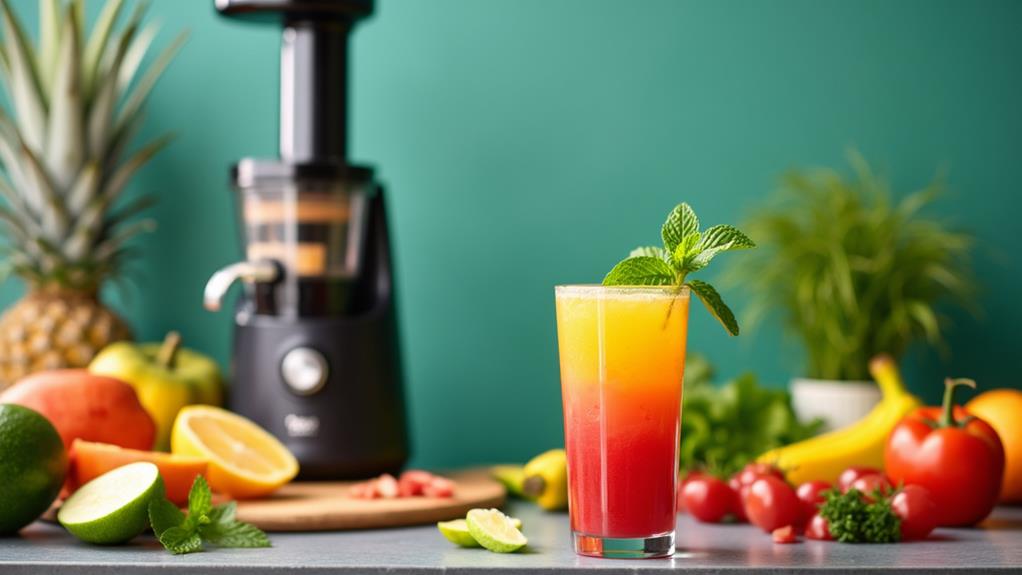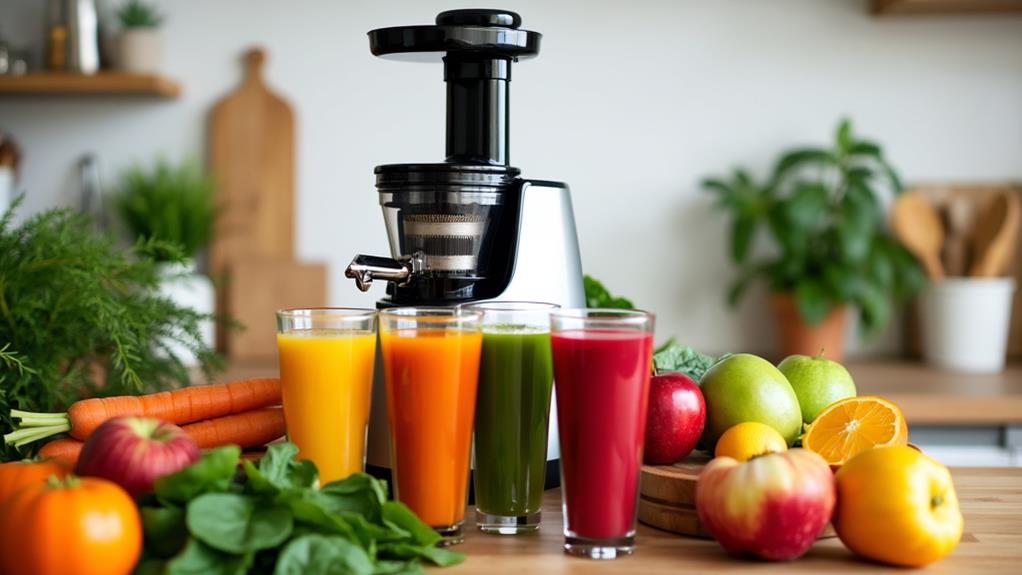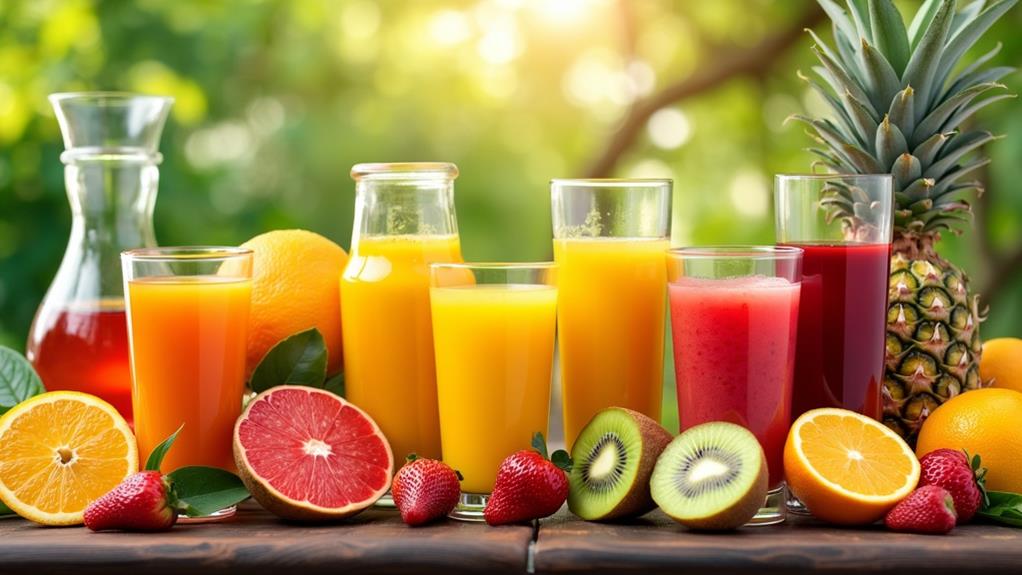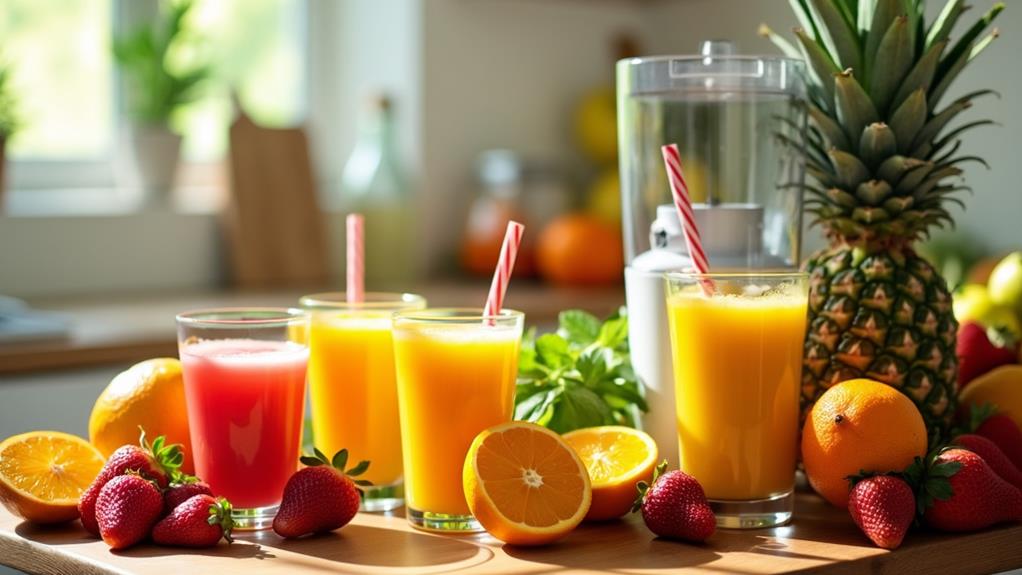Juicing Hygiene: Best Practices for Safe Juice Preparation
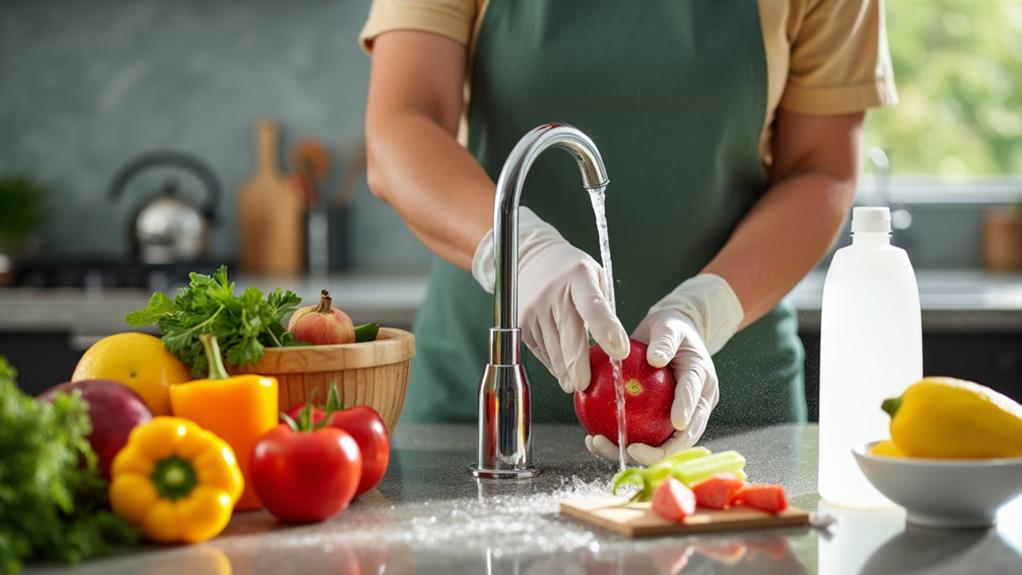
Ensuring proper hygiene during juice preparation at home is essential to prevent foodborne illnesses. While washing your hands and rinsing produce are crucial steps, they aren't sufficient on their own. It's important to use separate cutting boards for produce and other foods to avoid cross-contamination. Additionally, cleaning your juicer thoroughly and correctly is vital to prevent bacterial growth. By following these best practices, you can ensure your juice is both safe and delicious. Let's explore the key steps to maintain a healthy and hygienic juicing routine.
Importance of Juicing Hygiene
Maintaining proper hygiene during juicing is crucial to prevent foodborne illnesses. Fresh-squeezed juices can harbor harmful bacteria if not handled correctly. Always wash your hands for at least 20 seconds before and after juice preparation to significantly reduce the risk of contamination. This simple step is vital for food safety.
Thoroughly washing fruits under running water helps remove surface dirt and potential contaminants. This step is essential in preventing foodborne illness, as even minimal bacterial presence can lead to serious health issues. Use separate cutting boards and utensils for fruits and vegetables to minimize cross-contamination, ensuring your juice is safe to consume.
Regular cleaning and sanitizing of your juicing equipment after each use is also key. Bacteria can easily accumulate on surfaces and equipment, so eliminating these germs is necessary for safe juice preparation. By following these steps, you'll reduce the risk of foodborne illnesses and enjoy fresh, delicious juice with peace of mind.
Choosing Safe Produce
After ensuring your juicing process is hygienic, the next step is to choose safe produce. Always opt for fresh fruits and vegetables, preferably organic, to minimize exposure to harmful pesticides and contaminants. When selecting produce, inspect each item carefully for any signs of damage, bruises, or mold. Damaged or bruised areas can harbor bacteria that cause foodborne illnesses, so it's crucial to avoid juicing compromised produce.
Before juicing, wash all fruits and vegetables thoroughly under running water. This step is essential for removing dirt, bacteria, and any residues that might be on the surface. For firm produce, use a clean produce brush to scrub all surfaces effectively. This extra step ensures that even the smallest particles are removed, keeping your juice as safe and clean as possible.
Proper Hand Washing
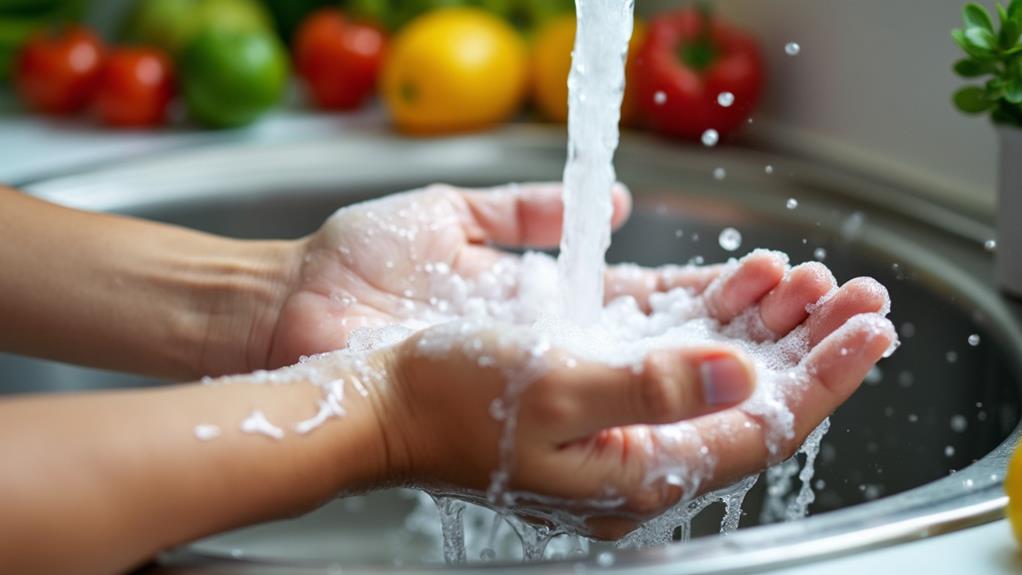
When preparing juice, wash your hands with soap and warm water for at least 20 seconds to eliminate harmful bacteria and contaminants. Scrub all areas, including between fingers and under nails, for thorough cleaning. Dry your hands with paper towels or air dryers to prevent transferring bacteria to your produce. Wash your hands again after handling raw fruits and vegetables to minimize cross-contamination risks.
Effective Hand Washing Techniques
Proper hand washing is essential for maintaining juicing hygiene, ensuring that harmful bacteria and contaminants are effectively removed. Start by washing your hands with soap and warm water for at least 20 seconds before and after handling produce. This practice significantly reduces health risks by removing bacteria or contaminants you may have encountered.
Be sure to lather the soap well, covering all areas of your hands, including between your fingers and under your nails, for maximum cleanliness. After washing, dry your hands with a clean towel or paper towel, as wet hands can transfer germs more easily.
When washing produce under running water, avoid touching your face, hair, or any other surfaces to prevent cross-contamination. This ensures that your hands remain clean throughout the juicing process.
Wash your hands frequently, especially when switching between different types of produce, such as raw fruits and vegetables. By following these effective hand washing techniques, you can significantly reduce health risks and ensure a safe and enjoyable juicing experience.
Reducing Cross-Contamination Risks
Cross-contamination poses a significant risk in juicing hygiene. Proper hand washing is your primary defense against harmful bacteria. Wash hands thoroughly with soap and warm water for at least 20 seconds before and after handling fruits and vegetables. This step is essential for ensuring your juice remains safe to consume.
It's important to wash your hands correctly. Use separate cutting boards for raw produce and other food items to prevent bacterial transfer. After washing, dry hands with a clean towel or paper towel to minimize recontamination.
Maintaining food safety is a shared responsibility. Regularly remind everyone involved in juice preparation to follow proper hand washing protocols. Avoid touching your face, hair, or other surfaces during juice preparation to maintain a hygienic environment.
Here's a quick checklist to keep you on track:
- Wash hands thoroughly with soap and warm water for at least 20 seconds.
- Use separate cutting boards for raw produce and other food items.
- Dry hands with a clean towel or paper towel after washing.
Cleaning Fruits and Vegetables
Before juicing, thoroughly wash all fruits and vegetables under running water to remove dirt and bacteria. Use a clean produce brush for firm items like cucumbers and potatoes, and cut away any damaged or bruised areas that could harbor harmful bacteria. Dry everything with a clean towel to reduce moisture and bacteria before cutting or juicing.
Thorough Washing Methods
When preparing to juice, it's essential to thoroughly wash your fruits and vegetables to ensure they are safe for consumption. Proper cleaning not only enhances the flavor of your food but also protects your health.
Start by washing your hands for at least 20 seconds with soap and warm water before and after handling produce. This step is crucial in preventing cross-contamination. Next, rinse all fruits and vegetables under running water, even if you plan to peel or cut them. This practice helps remove dirt, bacteria, and pesticide residues that could otherwise contaminate your juice.
For firm produce like potatoes and cucumbers, use a clean produce brush to scrub their surfaces. This ensures that all nooks and crannies are free of potential contaminants. After rinsing, dry your produce with a clean towel. Drying is an additional step that helps reduce the risk of bacteria and prepares your ingredients for juicing.
Here are some quick tips:
- Hand washing: Always wash for 20 seconds before and after handling produce.
- Rinsing: Rinse all produce under water, whether peeled or not.
- Brushing: Scrub firm fruits and vegetables with a clean brush.
Following these thorough washing methods will ensure your juice is both safe and delicious!
Removing Contaminated Areas
To ensure the safety of your juice, it is crucial to remove any damaged or bruised areas from fruits and vegetables. These compromised sections can harbor harmful bacteria that can contaminate your juice. Begin by inspecting all your produce and cutting away any damaged or bruised parts. This step is essential to ensure that only the cleanest portions make it into your juicer.
Next, thoroughly wash all your produce under running water for at least 20 seconds. This helps eliminate dirt, pesticides, and potential pathogens. For firm produce like cucumbers and carrots, use a clean produce brush to scrub away contaminants on their surfaces, ensuring any stubborn particles are effectively removed.
After washing, dry your produce with a clean towel or paper towel. Drying helps reduce the number of bacteria that might remain after washing. For leafy greens, separate and rinse each leaf individually to ensure all surfaces are clean and free from contaminants. By following these steps, you will ensure that your juicing ingredients are as safe and clean as possible, thereby reducing the risk of contamination in your fresh juice.
Equipment Sanitation
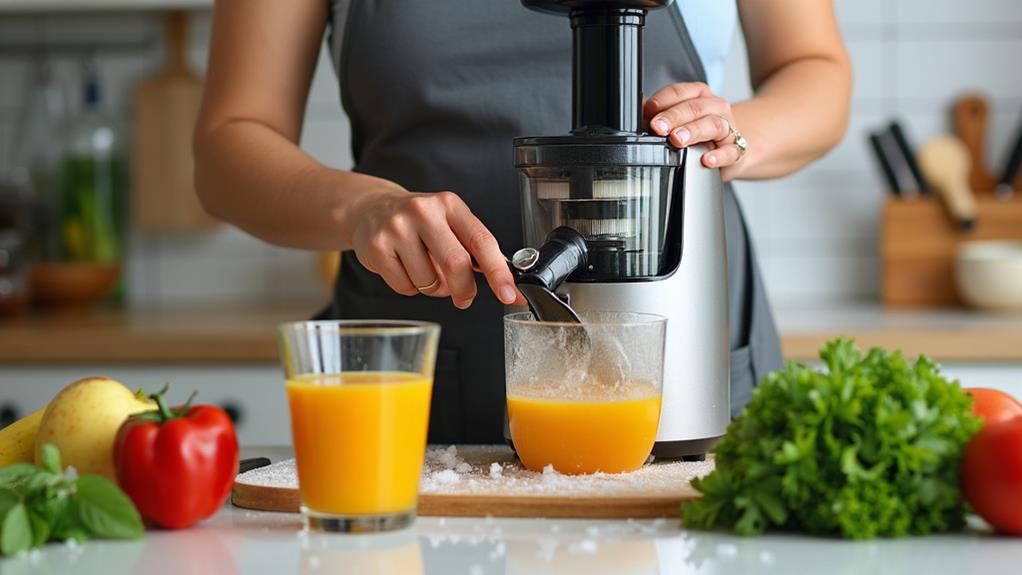
Maintaining impeccable hygiene is crucial for safe and healthy juicing. To ensure your juice is free from harmful bacteria, focus on proper equipment sanitation. Start by cleaning all juicing equipment, including juicers, cutting boards, and knives, with warm, soapy water after each use. This practice helps prevent bacterial growth and contamination.
Disassemble your juicer according to the manufacturer's instructions and thoroughly clean all parts, especially those that come into direct contact with produce. Even the smallest crevices can harbor bacteria if not properly cleaned. Use a clean produce brush to scrub firm fruits and vegetables before juicing, removing dirt and potential pathogens from the surface to ensure you're starting with clean produce.
After washing, store your juicing equipment in a clean, dry area to minimize exposure to contaminants and maintain hygiene between uses. Verify that all juicer parts are completely air-dried before reassembling them, as moisture can promote bacterial growth.
- Disassemble and clean thoroughly to prevent bacteria.
- Use a produce brush for scrubbing produce.
- Store juicer parts in a dry, clean area.
Safe Juice Storage
After ensuring your equipment is thoroughly sanitized, focus on proper juice storage to maintain its safety and freshness. Use airtight containers to prevent oxidation and contamination, with glass jars being the ideal choice as they preserve nutrients more effectively than plastic. Immediately refrigerate your juice at temperatures below 41°F (5°C) to inhibit bacterial growth and ensure safety.
Consume your juice within 24-48 hours for optimal quality and nutritional value. Label your containers with the preparation date to easily track freshness and avoid consuming expired juice. Regularly monitor your refrigerator's temperature to ensure it remains below 41°F (5°C), minimizing the risk of foodborne illness.
Here's a quick reference table to help you remember:
| Storage Tip | Emotional Impact |
|---|---|
| Use airtight glass containers | Preserve essential nutrients |
| Refrigerate immediately | Ensure family safety |
| Consume within 24-48 hours | Enjoy the freshest flavors |
| Label with preparation date | Avoid consuming expired juice |
| Monitor storage temperatures | Peace of mind for your health |
Recognizing Contamination Signs
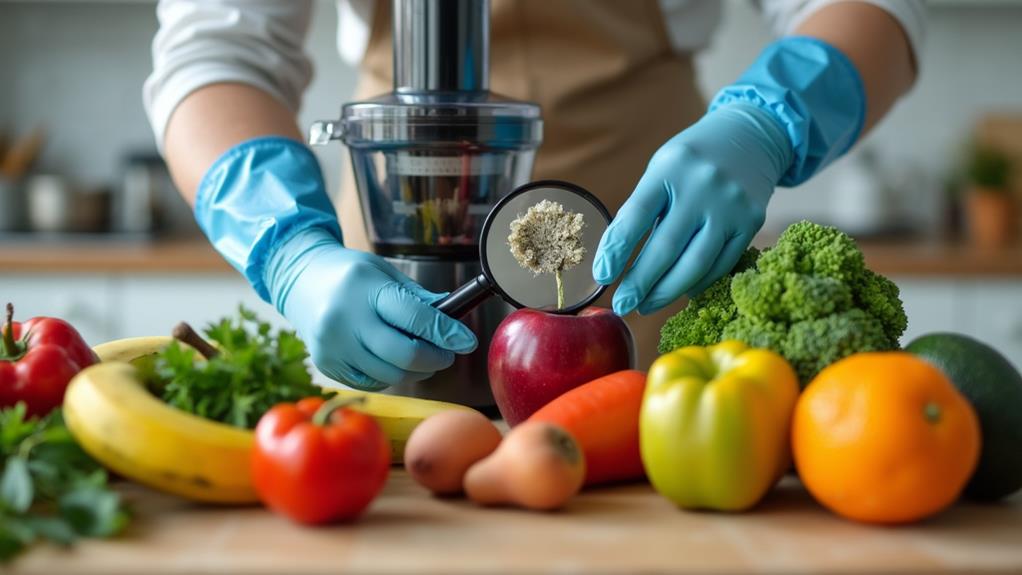
Ensuring the safety of your juice starts with recognizing contamination signs in your produce. Watch for visible spoilage such as mold, unusual discoloration, or sliminess on fruits and vegetables. These signs indicate the presence of harmful bacteria and should prompt you to discard the affected items.
Damaged or bruised produce can serve as entry points for bacteria, compromising juice safety. Always inspect your fruits and vegetables for any damage before use.
Proper storage is crucial. Produce left at room temperature for extended periods can harbor bacteria, making it unsafe for consumption. Ensure your produce is stored correctly to prevent contamination.
Be extra cautious with pre-cut or pre-packaged fruits and vegetables. Due to increased handling, these items have a shorter shelf life and are more prone to contamination. Inspect them thoroughly before use.
Key Points to Remember:
- Check for mold, discoloration, or sliminess.
- Avoid damaged or bruised produce.
- Ensure proper storage to prevent bacterial growth.
- Thoroughly inspect pre-cut or pre-packaged items.
Handling Foodborne Illness
Handling foodborne illness swiftly and effectively is vital to mitigate its effects. If you suspect you've consumed contaminated juice, monitor for symptoms such as vomiting, diarrhea, and abdominal pain, which can appear 1-3 days post-ingestion. Vulnerable groups, including children and the elderly, are especially at risk. Fresh-squeezed or raw juices can harbor harmful bacteria, so it's essential to take preventive measures.
Thoroughly wash all fruits and vegetables under running water before juicing to eliminate surface contaminants. Discard any damaged or bruised produce as these can introduce bacteria into your juice. Note that untreated juices sold in stores or farmers' markets must be refrigerated and carry warning labels regarding the risk of foodborne illness.
Opt for pasteurized juices, as pasteurization effectively kills harmful bacteria. If you or someone you know becomes ill from juice consumption, contact a healthcare provider immediately. Additionally, report the incident to the FDA via your local Consumer Complaint Coordinator to help prevent future outbreaks and ensure safer juice products.
Regular Maintenance Tips
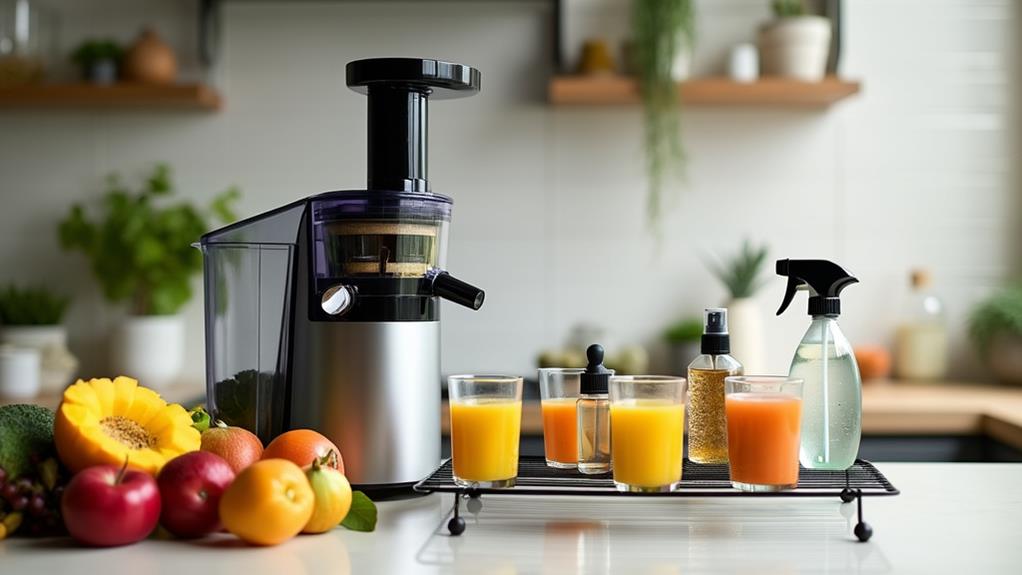
Maintaining your juicer is crucial for both its efficiency and your health. Regular upkeep ensures your juicer stays in optimal condition and prevents bacterial growth. Begin by inspecting your juicer for any signs of wear or damage, ensuring all parts function properly to maintain hygiene standards.
Always clean all juicer components with warm, soapy water immediately after use to prevent bacterial growth and cross-contamination. Follow the manufacturer's instructions for deep cleaning and maintenance routines, as these guidelines are designed to extend the life of your juicer and ensure safe operation.
Schedule routine maintenance checks to examine blades, seals, and other important parts, ensuring peak performance and safety. Store all juicer parts in a clean, dry area to avoid contamination and keep them away from potential sources of bacteria.
Here are some quick tips to help you stay on top of juicer maintenance:
- Inspect regularly: Frequently check for wear or damage.
- Clean immediately: Use warm, soapy water right after use.
- Follow guidelines: Adhere to the manufacturer's instructions for deep cleaning.

